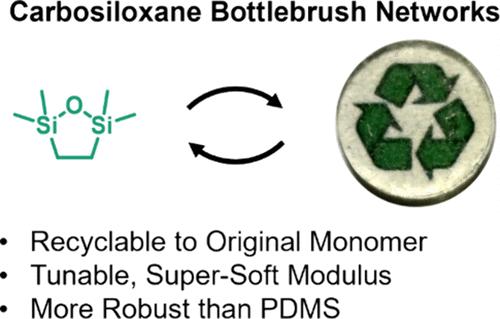当前位置:
X-MOL 学术
›
Macromolecules
›
论文详情
Our official English website, www.x-mol.net, welcomes your
feedback! (Note: you will need to create a separate account there.)
Carbosiloxane Bottlebrush Networks for Enhanced Performance and Recyclability
Macromolecules ( IF 5.1 ) Pub Date : 2024-11-08 , DOI: 10.1021/acs.macromol.4c02147 Taejun Eom, Patrick T. Getty, Michael Czuczola, Christopher M. Bates, Craig J. Hawker
Macromolecules ( IF 5.1 ) Pub Date : 2024-11-08 , DOI: 10.1021/acs.macromol.4c02147 Taejun Eom, Patrick T. Getty, Michael Czuczola, Christopher M. Bates, Craig J. Hawker

|
Silicone bottlebrush copolymers and networks derived from cyclic carbosiloxanes are reported and shown to have enhanced properties and recyclability compared with traditional dimethylsiloxane-based materials. The preparation of these materials is enabled by the synthesis of well-defined heterotelechelic macromonomers with Si–H and norbornene chain ends via anionic ring-opening polymerization of the hybrid carbosiloxane monomer 2,2,5,5-tetramethyl-2,5-disila-1-oxacyclopentane. These novel heterotelechelic α-Si–H/ω-norbornene macromonomers undergo efficient ring-opening metathesis copolymerization to yield functional bottlebrush polymers with accurate control over molecular weight and functional-group density. Si–H groups retained at the ends of side-chains after ring-opening metathesis copolymerization allow for the preparation of supersoft networks via hydrosilylation with cross-linkers such as tetrakis[dimethyl(vinyl)silyl]orthosilicate. In contrast to traditional PDMS systems, the incorporation of poly(carbosiloxane) side chains allows the resulting networks to be recycled back to the original monomer (>85% recovery) via depolymerization at elevated temperatures (250 °C) in the presence of base catalysts (potassium hydroxide and tetramethylammonium hydroxide). The recovered monomer was successfully repolymerized through anionic ring-opening polymerization with no decrease in structural fidelity or activity. In summary, this combination of unique (macro)monomer design and bottlebrush architecture creates new opportunities in sustainable practices by offering a robust, recyclable alternative to commercial silicone-based materials.
中文翻译:

碳硅氧烷 Bottlebrush 网络可提高性能和可回收性
据报道,与传统的二甲基硅氧烷基材料相比,源自环状碳硅氧烷的有机硅瓶刷共聚物和网络具有增强的性能和可回收性。这些材料的制备是通过杂化碳硅氧烷单体 2,2,5,5-四甲基-2,5-二硅烷-1-氧杂环戊烷的阴离子开环聚合合成具有 Si-H 和降冰片烯链末端的明确定义的异环螯大单体来实现的。这些新型异异螯合 α-Si-H/ω-降冰片烯大分子单体经过高效的开环复分解共聚,以产生对分子量和官能团密度进行精确控制的功能性瓶刷聚合物。开环复分解共聚后保留在侧链末端的 Si-H 基团允许通过使用交联剂(如四甲基[乙烯基)甲硅烷基]正硅酸盐)加氢硅烷化制备超软网络。与传统的 PDMS 系统相比,聚咝寝硅氧烷侧链的掺入允许在碱催化剂(氢氧化钾和四甲基氢氧化铵)存在下,通过在高温 (250 °C) 下解聚,将所得网络回收回原始单体(>85% 回收率)。回收的单体通过阴离子开环聚合成功再聚合,结构保真度或活性没有降低。总之,这种独特的(宏观)单体设计和瓶刷结构的结合为可持续实践创造了新的机会,为商业有机硅材料提供了坚固、可回收的替代品。
更新日期:2024-11-08
中文翻译:

碳硅氧烷 Bottlebrush 网络可提高性能和可回收性
据报道,与传统的二甲基硅氧烷基材料相比,源自环状碳硅氧烷的有机硅瓶刷共聚物和网络具有增强的性能和可回收性。这些材料的制备是通过杂化碳硅氧烷单体 2,2,5,5-四甲基-2,5-二硅烷-1-氧杂环戊烷的阴离子开环聚合合成具有 Si-H 和降冰片烯链末端的明确定义的异环螯大单体来实现的。这些新型异异螯合 α-Si-H/ω-降冰片烯大分子单体经过高效的开环复分解共聚,以产生对分子量和官能团密度进行精确控制的功能性瓶刷聚合物。开环复分解共聚后保留在侧链末端的 Si-H 基团允许通过使用交联剂(如四甲基[乙烯基)甲硅烷基]正硅酸盐)加氢硅烷化制备超软网络。与传统的 PDMS 系统相比,聚咝寝硅氧烷侧链的掺入允许在碱催化剂(氢氧化钾和四甲基氢氧化铵)存在下,通过在高温 (250 °C) 下解聚,将所得网络回收回原始单体(>85% 回收率)。回收的单体通过阴离子开环聚合成功再聚合,结构保真度或活性没有降低。总之,这种独特的(宏观)单体设计和瓶刷结构的结合为可持续实践创造了新的机会,为商业有机硅材料提供了坚固、可回收的替代品。


















































 京公网安备 11010802027423号
京公网安备 11010802027423号